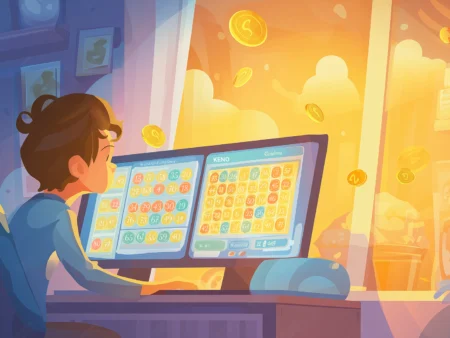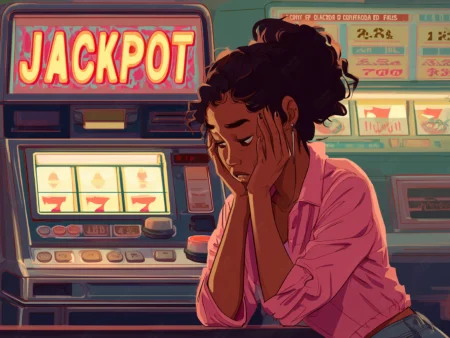You’ve probably heard it: someone swears they cracked the keno code. A diagonal grid that “always hits.” A lucky corner combo that paid out big last Tuesday. Maybe even a secret formula making the rounds in Telegram chats like a whispered cheat code.
Sounds good, but here’s the real story: if any of those tricks actually worked long-term, the casinos would’ve shut them down years ago.
Keno is a numbers game, but not in the way most casual players assume. It’s driven by RNG (random number generators), not patterns, grids, or previous draws. That doesn’t mean it’s hopeless, it just means strategy in keno looks very different from, say, blackjack or poker.
Still, there are ways to play smarter. The key is separating what influences your outcomes, payout tables, spot count, session discipline, from what doesn’t: shape-based superstitions, cold/hot number myths, or the fantasy of a “winning pattern.”
This guide cuts through the noise. We’ll break down the most common myths about secret keno patterns, show what actually affects your results, and walk you through proven tips seasoned players use to stretch bankrolls and maximize value.
Let’s start by burying the biggest myth of all, that the keno grid is hiding some magical number sequence just waiting to be unlocked.
Table of contents
- Are Secret Keno Patterns Real or Just a Marketing Gimmick?
- What Actually Impacts Your Keno Odds
- Common Keno Pattern Myths, Busted
- Smart Keno Tips That Actually Help
- Where to Play Keno Online (and Why It Matters)
- Final Word: Stop Chasing Magic, Start Playing Smart
- FAQ: Keno Strategy, Patterns, and Odds, Real Answers
Are Secret Keno Patterns Real or Just a Marketing Gimmick?
The idea of a secret keno pattern is seductive. It plays on a deep-rooted instinct: the human need to find order in chaos. A tidy diagonal, a repeating grid, the same “lucky” cluster every round, it all feels like control. Like you’re spotting something others missed.
But here’s the thing: there’s no hidden math or logic behind it. What you’re seeing isn’t a pattern, it’s randomness disguised as meaning. And in a game built on RNG, that illusion can be costly.
Why Players Believe in Patterns
Humans are hardwired to chase patterns, even where none exist. It’s comforting. It gives a sense of agency. When you’re looking at a blank keno grid, the urge to create structure, a diagonal, a corner setup, yesterday’s exact spread, feels like a smart move.
And when that setup does hit once? That’s all it takes. Suddenly it becomes “my system.” Anecdotal wins travel fast, in Discord chats, forums, or casino floors:
“I always play the X pattern, nailed 7 out of 9 last weekend.”
That kind of variance sticks with you. It feels like proof, even when it’s just noise.
It’s the same thinking behind lottery rituals, birthdays, anniversaries, repeating numbers. The ritual becomes the strategy. But in games like keno, where every number has equal probability, those rituals don’t change your odds. They just make the experience feel more personal.
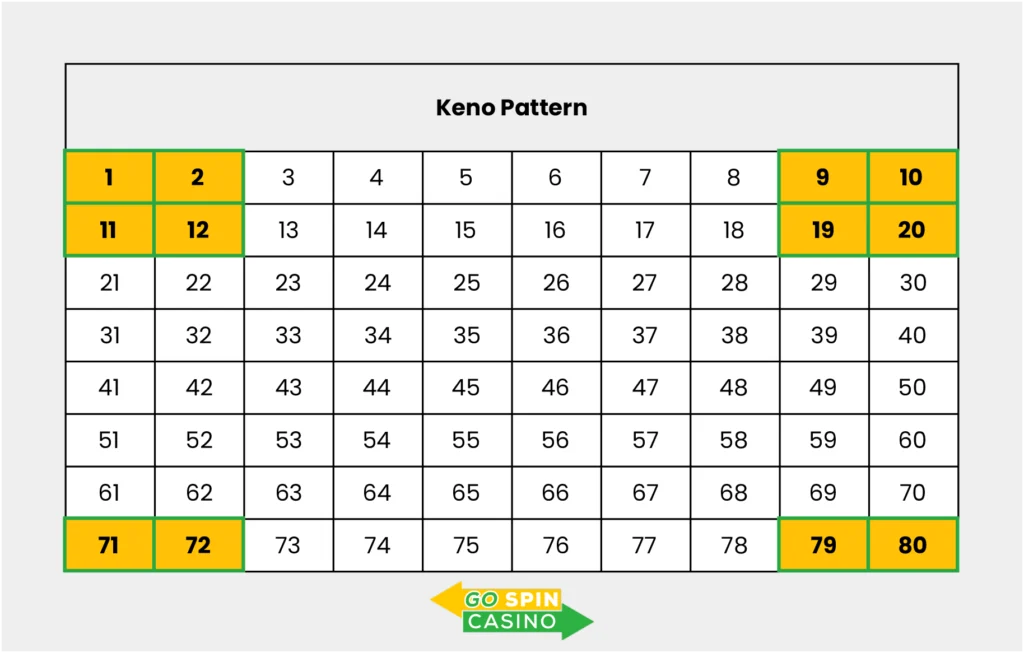
Myth: “Corners are ‘hot spots’ on the board.”
Reality: RNG doesn’t favor screen positions — corner numbers are no more likely than center ones.
The Truth: Keno is RNG-Based
Here’s the reality: every single keno draw is independent.
It doesn’t matter what hit last round. Or the round before that. Or what didn’t hit. There’s no “hot corner,” no memory, no rhythm. Each result is fresh.
Keno, whether you’re playing online, through a video machine, or via a live draw, runs on random number generator (RNG) software. It’s the same tech used in slot machines: instant, unbiased, and immune to your betting behavior.
Think of it like flipping a coin. If you hit heads five times in a row, the sixth flip is still 50/50. That’s how RNG works. Your brain might scream “tails is due!”, but the math doesn’t care.
And no, the casino isn’t rigging the game with some dark algorithm. But the math is built to favor the house, through calculated odds, payout tiers, and expected value over time. That’s not shady. That’s just how gambling works.
So if your strategy revolves around “numbers that haven’t hit in a while,” or trying to outguess the RNG… you’re not playing smart. You’re chasing patterns that don’t exist.
What Actually Impacts Your Keno Odds
So if secret patterns are off the table, what can you control in keno?
More than you might think, just not in the ways TikTok tipsters or YouTube “systems” would have you believe. Real keno strategy isn’t about chasing numbers. It’s about choosing games wisely, managing your sessions, and understanding where your edge (however small) can come from.
Let’s break down what actually moves the needle.
Know Your Payout Table
This is where most players lose money without even realizing it, they ignore the pay table. In keno, payouts can vary massively between casinos, even if the game itself looks identical.
Example:
Pick 8 numbers on a 10-spot ticket.
- At Casino A, hitting 6 might pay 20x your bet
- At Casino B, it pays only 7x
That’s not just a minor tweak, that’s a 65% drop in return for the exact same outcome. Multiply that over dozens or hundreds of sessions and it’s the difference between grinding and sinking.
Even hitting 6 out of 10, a decent result, could mean anything from break-even to bonus bankroll, depending entirely on the casino’s payout structure.
How Many Numbers Should You Pick?
This debate never ends, but here’s the truth backed by both math and real-world play: the sweet spot is usually 4 to 7 picks.
Here’s why:
- Fewer than 4? More frequent hits, but weak payouts.
- 8 or more? Payouts spike, but hit rates plummet, now you’re in lottery territory.
- 10+ picks? Fun for jackpot chasers, but not sustainable if you’re after steady wins.
Quick Note: Picking more numbers doesn’t improve your chances, it just dilutes the probability across more combinations. In most cases, it means you’ll hit some numbers, but rarely enough to trigger a worthwhile payout.
Bankroll and Game Selection Matter
This is where seasoned players separate themselves from the crowd. Strategy in keno isn’t about picking the “right” numbers, it’s about playing the right game the right way.
Fixed vs. Progressive Keno
- Fixed games = consistent, predictable payouts
- Progressive keno = growing jackpots, but lower base wins
If you’re not specifically chasing the big pool, fixed pays better long-term.
Video Keno vs. Live Draws vs. Online RNG
- Video/online RNG: Faster pace, lower bets, ideal for volume and testing
- Live keno: Slower, more social, but fewer data points for tracking strategy
Online gives you speed and session control, crucial if you’re tracking results or testing patterns (even for fun).
Short Sessions vs. Long Grinds
This comes down to rhythm.
Stretching €/$ 100 across 200 rounds at €/$ 0.50 gives you:
- More feedback
- More engagement
- Less emotional tilt
Compare that to firing off €/$ 5 bets over 20 rounds, fun, but swingy. Think like a poker player: know when to bet, when to watch, and when to walk.
Playing smarter means zooming out.
It’s not about chasing yesterday’s numbers, it’s about selecting the game type, payout table, bet size, and rhythm that match your goals. That’s the real edge.
Common Keno Pattern Myths, Busted
One of the fastest ways to level up your keno game? Stop believing the myths.
The rituals. The hunches. The number shapes that look clever but do absolutely nothing for your odds.
These so-called “secret keno patterns” aren’t just harmless, they distract you from the strategies that actually influence results. Let’s break down the most common ones players still chase (and why they don’t hold up).
Myth 1: “The Diagonal Pattern”
This one’s everywhere, players marking out a perfect diagonal, convinced it gives them an edge. It’s clean. It’s deliberate. And when it lands, it feels like proof.
But from a math perspective? It’s no different than picking random numbers across the board.
RNG doesn’t care about shape or symmetry. It’s pulling from a fixed range, not a visual layout. That diagonal only exists in your head, the software doesn’t “see” it.
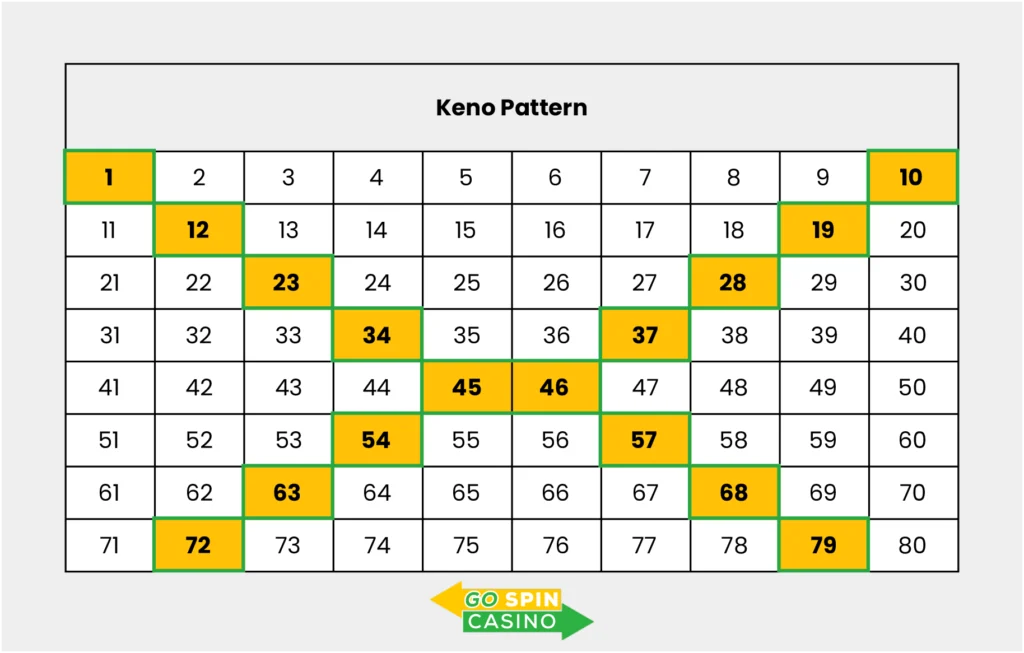
Myth: “Diagonal spreads out my numbers evenly.”
Reality: Pure RNG — no advantage to layout.
Myth 2: “The Same Numbers Hit Again”
This is classic recency bias: the belief that if a number just hit (or keeps hitting), it’s either due to repeat… or due to disappear.
Some players chase yesterday’s hot numbers. Others avoid them entirely. Both are wasting their time.
Keno isn’t a memory game. Every draw is independent. If number 27 hit five times today, the odds for it hitting tomorrow are still the same. Past performance doesn’t predict future draws, not in keno, and not in RNG-based games.
Myth 3: “Middle Grid Numbers Hit More Often”
Surprisingly common, and totally false. Some swear the center of the board is “hot” because it looks more balanced or seems to land more often.
But here’s the truth: the grid is just a user interface. RNG picks numbers based on coded ranges, not visual position. There’s no bias toward the middle, corners, edges, or any section of the screen.
What’s happening is perception, you’re more likely to notice and remember clusters that show up near the center of your screen.
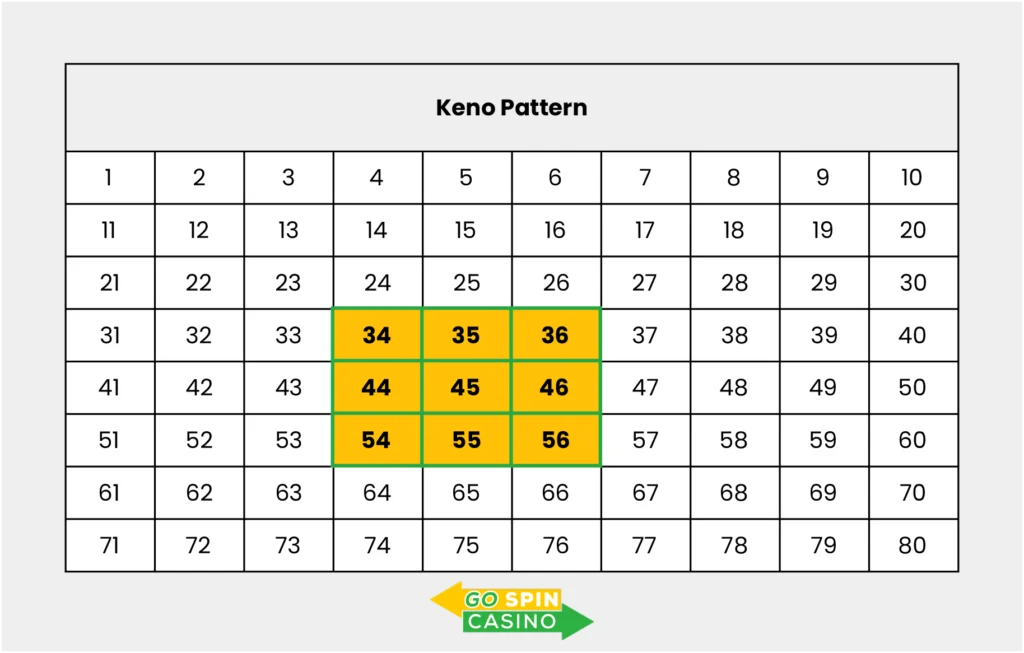
Myth: “Middle numbers hit more often.”
Reality: Central placement is just screen positioning — no impact on draw odds.
Pro Tip: Stop Chasing Grids, Start Chasing Value
If you want a real edge, stop drawing shapes and start making strategic choices:
- Choose keno games with better payout tables
- Pick realistic spot ranges (4–7)
- Treat your bankroll like a session budget, not a slot machine jackpot chase
That’s how experienced players tilt the odds closer to their side. Not with triangles. Not with corners. But with real decisions that influence risk, return, and rhythm.
Smart Keno Tips That Actually Help
We’ve busted the myths. We’ve covered the fundamentals. Now let’s get practical.
These are real-world keno tips, tested by players who care about bankroll survival, not magic formulas. They won’t guarantee wins (nothing will), but they’ll help you play smarter, stay in control, and actually learn from your sessions.
Stick to One Game and Learn Its Quirks
Jumping between keno variants might feel exciting, but it kills your ability to notice patterns in game behavior, not number draws, but mechanics that actually matter.
Instead, stick with one version, online RNG, video terminal, or live draw, and learn how it plays:
- What’s the sweet spot for payout ratios?
- Are there bonus multipliers or side bets?
- Does the game offer a progressive jackpot or flat returns?
Staying consistent helps you spot technical trends, like how often certain hit thresholds break even. That’s the kind of data casual players never see, but sharp ones use to adapt.
Avoid Quick Pick if You Like Control
Quick Pick is the autoplay of keno, fast, effortless, and completely random.
If you’re playing casually or don’t care about tracking picks, it’s fine. But if you want more control over what you’re testing or tracking, manual selection is better.
Just don’t confuse control with odds. Manually picking your numbers doesn’t improve your chances, the RNG doesn’t care. But it does let you stay consistent and analyze what’s happening.
It’s about visibility, not edge.
Track Your Sessions (Yes, Seriously)
Most keno players fly blind. They remember big hits, forget losses, and rinse-repeat without knowing what’s working.
That’s a mistake.
Tracking your sessions, even in a simple Google Sheet, gives you a real view of performance.
Start with:
- How often you hit 3+, 4+, or 5+ numbers
- Which pick counts give you the most consistency
- Whether certain times of day or session lengths perform better
- How your results change between game types or bet sizes
You don’t need fancy software, just enough data to separate hunches from facts. It’s the same logic poker players use to track hands. If you’re serious about improving, you need feedback.
Where to Play Keno Online (and Why It Matters)
Here’s what most casual players miss: where you play keno can impact your results just as much as how you play it.
Not all keno games are created equal. Some give you better odds, lower stakes, or bonus features. Others quietly drain your bankroll with tight payouts and rigid bets. Even if you’ve got the right strategy, it won’t mean much if you’re playing on the wrong platform.
Let’s break down why your choice of casino matters, and what to look for.
RTP Varies by Game and Provider
Keno RTP (Return to Player) can swing hard between providers. Some titles run in the 92–95% range, pretty strong for a lottery-style game. Others? You’ll be lucky to break 85%.
That 7–10% difference might seem small, but over hundreds of rounds, it adds up fast. If you’re serious about how to win at keno, you need to factor in RTP the same way you’d shop for blackjack rules or slot volatility.
Look for Promo-Boosted or Bonus-Friendly Keno
While keno doesn’t get the promo love that slots do, a few smart operators run:
- Cashback events
- Win multipliers
- Keno leaderboards
These don’t change the math behind the game, but they add free equity to your sessions, especially if you’re already planning to play.
If a casino is actively supporting keno players, that’s a strong signal they’re worth checking out..
Low-Minimum Bet Games Are Key for Strategy Testing
If you’re tracking hit rates, testing pick ranges, or simply experimenting with different games, you’ll want low-stake flexibility.
Look for games with €/$ 0.10 to €/$ 0.20 minimums, that’s your sweet spot for volume-based learning.
Think of it like A/B testing in an ad campaign:
- More rounds = more data
- More data = sharper insights
- Sharper insights = better decisions over time
It’s not glamorous, but it’s how serious players get an edge.
Want to skip the guesswork? Explore our list of top-rated keno casinos
Every casino we feature has:
- Transparent payout tables
- Verified fast withdrawals
- Flexible bet ranges
- And many support recurring keno promos or bonus-friendly play
Choose your keno site like you’d choose your toolset: smart, reliable, and built to boost results, not randomize them.
Final Word: Stop Chasing Magic, Start Playing Smart
Still hoping there’s a secret keno pattern that unlocks guaranteed wins? Time to drop the fantasy.
There’s no magic grid. No hidden number combo. No cheat code the pros are keeping to themselves. That kind of thinking doesn’t help, it keeps players chasing illusions, not results.
But here’s the upside: smart keno play is absolutely real.
You can make better decisions, stretch your bankroll longer, and get more out of every session, if you treat keno like a strategy game, not a superstition.
Here’s the winning mindset:
- Learn the payout tables before you bet
- Pick your spot counts with intention
- Track your sessions, don’t play blind
- Choose casinos with better RTP and active keno promos
Forget the patterns. Play with purpose.
FAQ: Keno Strategy, Patterns, and Odds, Real Answers
There isn’t one. Every number combination has the exact same odds of hitting. Diagonals, corners, lucky number clusters, they all feel smart, but they’re statistically meaningless. Focus on payout structures and spot count, not shapes.
Yes, just not the kind most casual players expect. Keno strategy is about managing your session: understanding pay tables, picking realistic numbers (usually 4–7), choosing games with strong RTP, and playing at stakes that let you test and learn over time.
The sweet spot for most players is between 4 and 7 numbers. Fewer than that, and the payouts are weak. More than that, and your chances of hitting enough matches drop dramatically. You want a balance between hit frequency and potential return.
Yes. Whether you’re playing video keno, live draws, or online versions, all outcomes are generated by RNGs (random number generators). Each draw is independent. The system doesn’t remember previous results, and it doesn’t adjust to your betting behavior.
No, and anyone claiming otherwise is selling fiction. Keno is a game of chance with a built-in house edge. You can play smarter and get more value out of each session, but there’s no guaranteed path to profit. The real edge comes from consistency, not magic.
